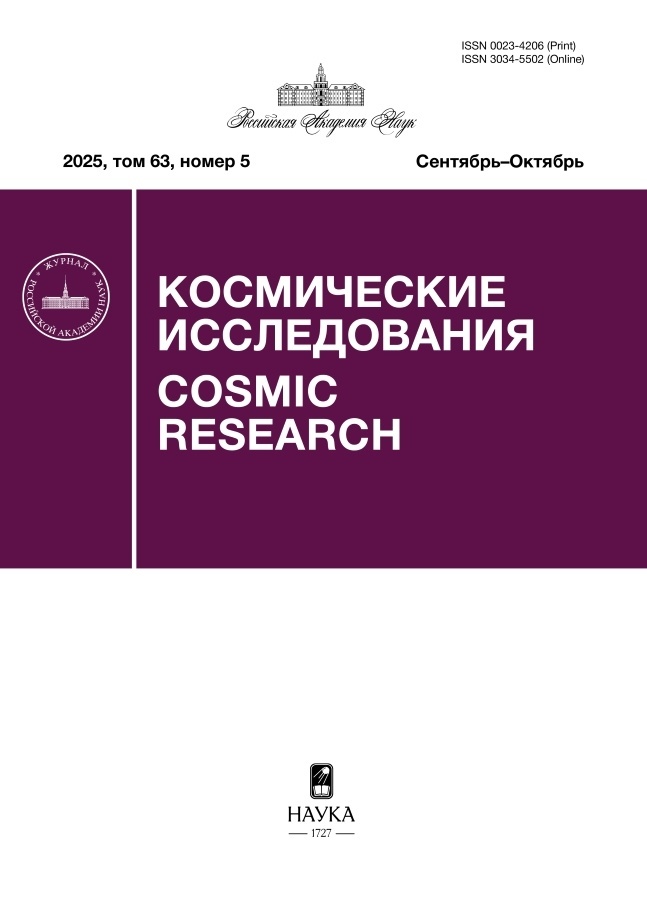Methods of a satellite formation orbital motion control based on consensus algorithms
- Авторлар: Dadashev R.R.1, Shestakov S.A.1
-
Мекемелер:
- Keldysh Institute of Applied Mathematics, Russian Academy of Sciences
- Шығарылым: Том 63, № 5 (2025)
- Беттер: 471-481
- Бөлім: Articles
- URL: https://journals.eco-vector.com/0023-4206/article/view/696716
- DOI: https://doi.org/10.31857/S0023420625050023
- ID: 696716
Дәйексөз келтіру
Аннотация
Methods for synthesizing control of the relative motion of a group of spacecraft are considered. The main goal is to develop a control strategy that compensates for the disintegration of the group caused by relative orbital drift. The control design employs techniques based on various types of graphs to describe satellite interactions. A proof is provided demonstrating the feasibility of eliminating relative satellite drift using a method based on directed graphs. The resulting algorithm is adapted to scenarios where one or more spacecraft in the group may malfunction. To derive the control in such cases, a modified version of the Raft protocol for achieving consensus in multi-agent systems is used. In addition to analytical derivations and the general methodology, the work presents results from numerical simulations.
Авторлар туралы
R. Dadashev
Keldysh Institute of Applied Mathematics, Russian Academy of Sciences
Хат алмасуға жауапты Автор.
Email: shestakov@keldysh.ru
Moscow
S. Shestakov
Keldysh Institute of Applied Mathematics, Russian Academy of Sciences
Email: shestakov@keldysh.ru
Moscow
Әдебиет тізімі
- Mesbahi M., Egerstedt M. Graph theoretic methods in multiagent networks. Princeton University Press, 2010. 424 p.
- Monakhova U., Ivanov D., Mashtakov Y. et al. Communication area estimation for decentralized control of nanosatellites swarm // Acta Astronautica. 2023. V. 211. P. 49-59. https://doi.org/10.1016/j.actaastro.2023.06.003
- Дадашев Р.Р., Шестаков С.А. Методика управления группой спутников на основе коммуникационных графов // Препринты ИПМ им. М.В. Келдыша. 2022. No 90. С. 1-31. https://doi.org/10.20948/prepr-2022-90
- Clohessy W.H., Wiltshire R.S. Terminal Guidance System for Satellite Rendezvous // J. Aerospace Sciences. 1960. V. 27. Iss. 9. P. 653-658. https://doi.org/10.2514/8.8704
- Fischer M.J., Lynch N.A., Paterson M.S. Impossibility of distributed consensus with one faulty process // J. Association for Computing Machinery. 1985. V. 32. Iss. 2. P. 374-382. https://doi.org/10.1145/3149.214121
- Lamport L. The part-time parliament // ACM Transactions on Computer Systems. 1998. V. 16. Iss. 2. P. 133-169. https://doi.org/10.1145/279227.279229
- Lamport L. Lower bounds for asynchronous consensus // Distributed Computing. 2006. V. 19. Iss. 2. P. 104-125. https://doi.org/10.1007/s00446-006-0155-x
- Oki B.M., Liskov B.H. Viewstamped replication: a general primary copy // Proc. 7th annual ACM Symposium on Principles of distributed computing - PODC'88. 1988. P. 8-17. https://doi.org/10.1145/62546.62549
- Skeen D. A Quorum-Based Commit Protocol // Proc. 6th Berkeky Workshop. 1982. P. 69-80.
- Junqueira F.P., Reed B.C., Serafini M. Zab: High-performance broadcast for primary-backup systems // IEEE/IFIP 41st International Conference on Dependable Systems & Networks (DSN). 2011. P. 245-256. https://doi.org/10.1109/DSN.2011.5958223
- Ongaro D., Ousterhout J. In search of an understandable consensus algorithm // USENIX Annual Technical Conference (USENIX ATC 14). 2014. P. 305-319. https://doi.org/10.5555/2643634.2643666
- Tariverdi A., Torresen J. Rafting Towards Consensus: Formation Control of Distributed Dynamical Systems. 2023. https://doi.org/10.48550/arXiv.2308.10097
Қосымша файлдар








